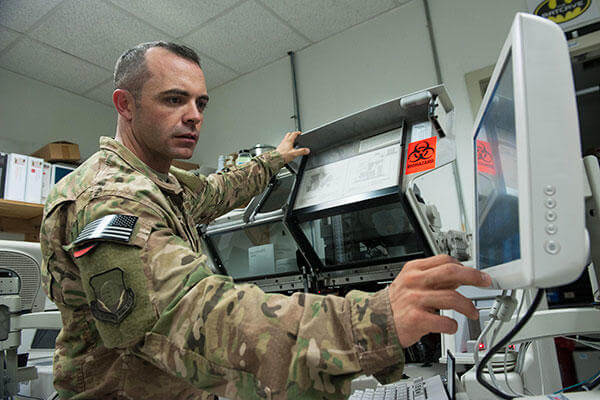BAGRAM AIRFIELD, Afghanistan — A key part of the 455th Air Expeditionary Wing's mission is providing effective advanced medical care here on the combat frontier.
But before a medical technician can take a patient's vital signs or a surgeon can operate, they must first have a facility and medical equipment that's ready to go.
That responsibility falls onto a small team of Airmen who provide the logistics and facilities management needed to keep Craig Joint Theater Hospital ready to care for patients.
"We're the backbone to make the hospital go. We're the support side of things; we make sure the clinicians have all the things they need and that the facility is functional and in good condition so the providers can come in and focus on their duty," said Maj. Thomas Naughton, the hospital administrator who's attached to the 455th Expeditionary Medical Group. "We work daily on repairs and maintenance to make sure services are available when needed. We're a 24/7 operation and regardless of how a patient comes to the clinic — whether it's medevac, aeromedical evacuation, driven to the emergency department, or patients walk in — the hospital is ready to go to provide patient care."
As the hospital administrator, Naughton said his responsibilities include overseeing the logistics section that provides the maintenance and supplies to keep the hospital working, as well as handling administrative duties to process the reports needed for higher headquarters. Some of his other duties include supporting manpower assessments and medical planning requirements needed during the drawdown.
One of the three Airmen keeping the hospital functioning is Tech. Sgt. Scott Hatch, a 455th EMDG biomedical equipment technician and facility manager. He ensures the clinic has the utilities, power, oxygen and supplies to operate.
"We make sure the staff has the equipment that they need and the facility is ready to support the mission," Hatch said. "Our physicians are capable of working in any environment, but the specific capabilities CJTH provides is a stable platform for advanced medical care. The facility management team has to make sure the facility is ready to treat patients at all times."
In a combat zone like Afghanistan, the facility manager also plays a key role in guaranteeing the facility is good to go during or after attacks.
"If something happened during an IDF (indirect fire) attack, I'd coordinate with first responders, contractors and all the other agencies on Bagram to get the facility back up and running so we can keep doing our mission," Hatch said. "My job as a facility manager is to make sure the facility is in intact."
Part of making sure the hospital is able to execute its Role 3 mission is making sure the equipment and supplies are ready.
"Over the course of a year, we have over 2,000 pieces of equipment that we'll do preventive maintenance on," Hatch said. "Everything from thermometers to the CT scanner, which is a vital piece of equipment for us to maintain a 98 percent survival rate of injured patients who come into the hospital."
For a hospital to get a Role 3 rating, it must be able to provide advanced surgical services and in-patient bed care. A Role 4 hospital provides rehabilitative services.
"We have the ability to provide surgical services and an intensive care unit that we can house patients in for post-surgery recovery," Naughton said. "We also have a ward where we can have patients stay for various amounts of time before they need to be transferred.
"A big part of Bagram is our aeromedical evacuation mission; we keep patients here until they are healthy enough for transportation to the next level of care like Landstuhl (Regional Medical Center), which is a Role 4 hospital."
Hatch and his team, Naughton said, have helped remedy some major challenges to keep patient care moving forward.
"There were a few times when maintenance issues came up in the middle of a mass casualty event and they made repairs on the fly," Naughton said. "They got the repairs done quickly and got the doctors their equipment so they could continue to provide care."
According to Naughton and Hatch, it has been a fulfilling experience to provide Role 3 medical care to injured troops.
"For me it's rewarding to be here and be part of this mission. I get to see the impact of my work," Hatch said. "You see patients come into the facility, go into the operating room, see them in the ward a few days later and then see them transported to Germany by the AE team. It's humbling and amazing to be a part of this."
Naughton shared the same sentiment.
"We get to help people with life, limb and eyesight medical care," he said. "As support personnel we get to see the medical operations as providers seamlessly care for patients. I like that I get to see patients come in, see the amazing things our medical providers do and then get the patients moved on to higher echelons of care."





























